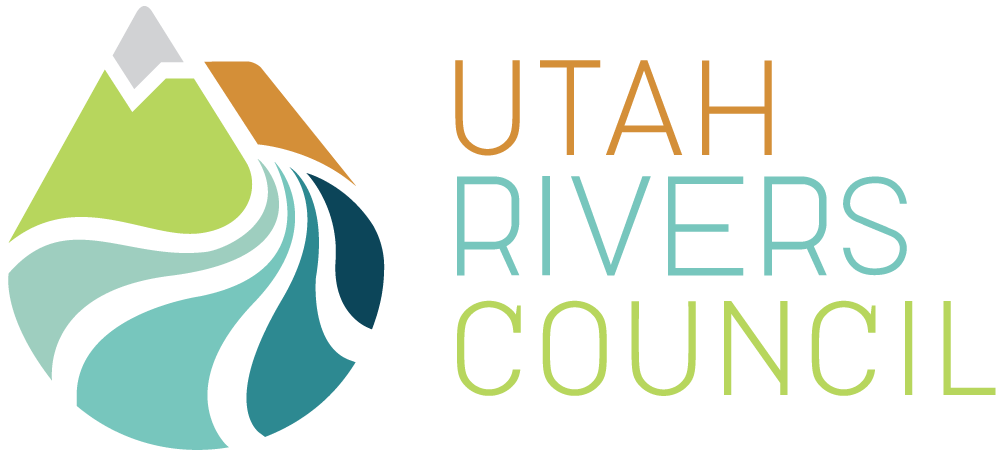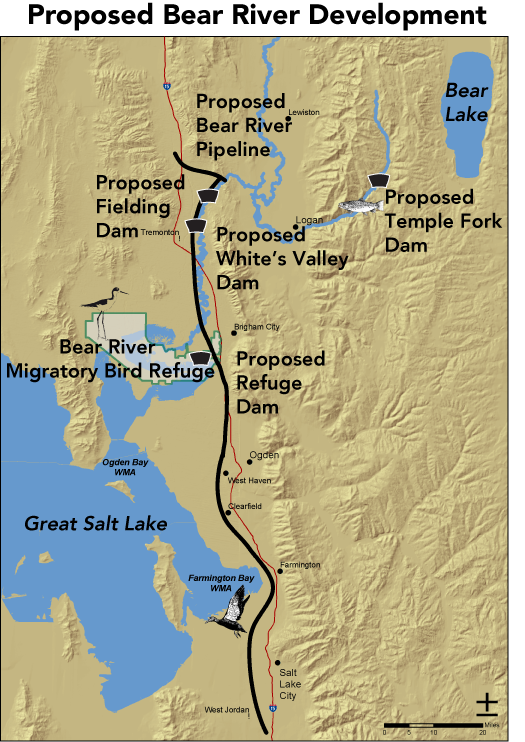Utah’s proposal to divert the Bear River upstream of the Great Salt Lake would dry up tens of thousands of acres of the West's largest remaining wetland ecosystem and cost taxpayers billions of dollars.
Trading wetlands for lawn water. Utah is proposing to divert 25-30% of the Bear River, which is the primary water source feeding the American West’s largest remaining wetland ecosystem, the Great Salt Lake. The project is being pursued to provide municipal water to the Wasatch Front, most of which will be used on lawns. This $2.9 billion water project will divert 220,000 acre-feet of water out of the Bear River each year, enough water for 2.4 million Americans’ annual water needs. The diversion will significantly lower the level of the Lake, destroying massive sections of internationally significant wetlands and impacting millions of migratory birds.
Current Status: Bear River Development continues to advance, largely behind closed doors and out of the public’s eye. Project proponents have been funding the project for a few years now, hoarding $72 million in sales tax money in a shadowy slush fund specifically for Bear River Development and the Lake Powell Pipeline. This account, formally known as the Water Infrastructure Restricted Account, is expected to accrue $502 million by 2028. All who pass through Utah and spend money are directly funding Bear River Development, rather than putting tax money towards urgent programs like healthcare and education.
The Utah Division of Water Resources is also currently advancing the water rights application for Bear River Development. In the shadows, Idaho is looking to get in on the project. This would increase the total water diverted annually from the Great Salt Lake to 400,000 acre-ft, which would be catastrophic to the Lake and the wildlife and residents who rely on a healthy ecosystem. Utah’s water cartel has been discrete about Bear River Development, hoping to keep it alive by keeping it hidden. With your help, the Utah Rivers Council will force these clandestine actions from the shadows and hold project proponents accountable for unnecessary, expensive and destructive water development projects.
No place to land. The wetlands that will be destroyed by Bear River development, including the federally managed Bear River Migratory Bird Refuge, are a critical habitat for 8 million migratory birds. Birds from over 230 species stop at the Lake coming from as far south as Chile, north to the Arctic Circle, and as far west as Siberia. More species gather at the Lake in larger numbers than anywhere else on the planet.
Utah water project salesmen have not studied the impacts of their diversion upon the migratory bird species dependent on Lake wetlands.
Exorbitant cost, no benefit. The project will include at least 3 new dams and a 90 mile-long pipeline, costing a staggering $2.9 billion just for construction. This will cause large increases in water rates, impact fees, and property taxes to repay the debt—consequences that will impact Utah families. Read the Bear River Debt Repayment report below, produced by the Economic Evaluation Unit at the University of Utah, which shows the debt that each city and its residents will be laden with if Bear River Development is built.
Unleashing a public health disaster. Northern Utah’s geography creates a natural trap for air pollution, specifically small airborne dust particles. Because the diversion will lower the Great Salt Lake, dust from the vast areas of exposed lakebed will become airborne when winds sweep across the area contributing to even worse air quality in the Wasatch Front—a region that already has some of the worst particulate air pollution problems in the nation. The video below is taken on November 16th, 2016 when the winds picked up between 3pm - 4pm, blowing dust from the exposed lakebed into the air of adjacent residents. Dr. Kevin Perry from the Dep. of Atmospheric Sciences at the University of Utah recently published a 2 year study on the minerals that are found in these dust “hot spots,” the majority of which have large concentrations of arsenic.
The Bear River and Great Salt Lake need your help.
The Great Salt Lake Advisory Council, charged with managing the health and future of the Great Salt Lake by the Utah Legislature, has commissioned a number of reports on the Lake. These reports analyze the current state of the Great Salt Lake and its future. Most concerning in their reports is the consistent decline of Lake levels and the effect of this decline on the ecological and economic vitality of the Lake.
Definition and Assessment of Great Salt Lake Health Report:
The report established a definition for a “healthy” Great Salt Lake and gave status updates about the current health of the Lake and future stressors. The report found that multiple areas of the Lake were in critical ecological health and reduced Lake levels were likely to continue to occur in the future if urgent action is not taken.
Consequences of Drying Lake Systems Around the World Report:
The Great Salt Lake is a terminal basin lake, meaning it doesn’t have any outflow. Terminal basin lakes are very unique but share many similar qualities. In order to understand more about how the Great Salt Lake functions and the impacts of declining lake levels, the GSLAC commissioned a study of other terminal basin lakes across the world. The report found that as terminal basin lakes around the world have declined, a plethora of impacts to public health and local economies followed.
Declining lakes levels leave behind exposed lakebeds, and when strong winds pass by, they pick up the exposed sediment, much of which is left from petrochemicals of nearby farms that drained into the rivers that ended in the lakes. This lakebed sediment becomes a source of dust and airborne pollutants and is associated with increases in asthma attacks, lung diseases, infections, and hospitalizations.
Local economies such as fisheries or industries who extract the rare minerals found in terminal lakes across the globe depend on such a valuable source of materials. Terminal lakes can provide billions of dollars into local economies, and are vibrant economic engines regionally.
The Great Salt Lake is a terminal basin lake, which means it brings Utah rich benefits to our environment and our economy. However, it also means that the Great Salt Lake is incredibly sensitive to changing climates and flows and will have critical and long-lasting consequences as Lake levels decline. We have opportunity to learn from others’ mistakes. We can still save the Great Salt Lake. We need only the will power to do so.
Economic Significance of the Great Salt Lake to Utah Report:
This report aimed to quantify the economic value of the Great Salt Lake. The report estimated that each year, the Lake produces $1.32 billion in total economic output and $375 million in total labor income supporting 7,706 full and part-time jobs annually. If we lose the Lake, we will lose a profound economic engine and job creator that is essential to our State. What do we call Salt Lake City without a Great Salt Lake?
Assessment of Potential Costs of Declining Water Levels in Great Salt Lake Report:
A later report examined the economic impacts of declining levels of the Great Salt Lake and quantified the cost of the decline. Levels could cost as much as $1.69 billion to $2.17 billion per year and over twenty years could cost the State’s taxpayers a staggering $25.4 billion to $32.6 billion! These astonishing numbers come from the loss of the mineral and brine shrimp industries, as well as the health care costs associated with the dust pollution from the exposed lakebed surface. The figure also attempted to quantify the “value” of losing the unique habitat and ecological functions of the Lake, but it is incredibly difficult to put monetary value on these more abstract functions of this important ecosystem.
Clearly, the ecological health and economic benefits of the Lake are paramount. The future of the Great Salt Lake depends on adequate inflows that maintain water levels. Bear River Development is an unparalleled threat to the Lake and the benefits it provides to all of us. To preserve the Great Salt Lake, we need legislators that will not bow to the demands of water development lobbyists and water agency staff who are driving massive spending. We instead need legislators courageous enough to oppose unnecessary and destructive diversions from drying up the Great Salt Lake.
Contact your legislator, and ask them to prioritize the preservation of our namesake, the Great Salt Lake.



